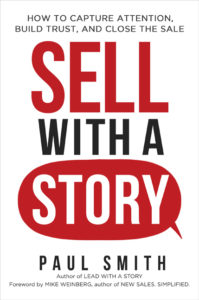Podcast: Play in new window | Download | Embed
Subscribe: RSS
Podcast (sell-with-a-story-series1): Play in new window | Download | Embed
Subscribe: RSS

Humans have a habit of judging people before even meeting them — often just based on what they do for a living. And unfortunately, just working in sales is sometimes enough to create rather powerful — and negative — preconceptions. And until you can get your prospect past those preconceptions, your job will be much harder than it should be.
So, you can wait for months while those ideas gradually fade away when your behavior doesn’t confirm them. Or, you can disabuse your buyer of those unfounded notions in about two minutes with a well-chosen story.
Here’s an example from a yearbook sales manager we’ll call “Brad.”
Prior to his yearbook sales job, Brad spent eight years teaching high school English and journalism in Nebraska. He was also the yearbook adviser. So he knew firsthand how big a role the publisher’s sales rep plays in the yearbook publishing process and how much of a hassle it is to change to a new publisher or even just a new rep.
But when Brad moved out of state in 2004 to take the yearbook sales job, he learned how those facts would make it difficult for him to get off to a good start. Yearbook publishing is highly competitive, with four well-resourced players in the high school yearbook market. In his first two months on the job, Brad learned that his competitors had things like this to say about him to his customers and prospects:
You know, that new rep isn’t going to be around long . . . He came from teaching, and he’ll probably go back . . . He’s from Nebraska; you know his kids will miss it and want to go back home soon . . . They won’t like it here anyway . . . You really don’t want to work with him. It’ll be such a hassle for you when he quits next year.”
Brad needed a way to combat that negative equity with anyone who’d heard it already. But perhaps even more importantly, he needed a subtle way to preempt it with anyone who hadn’t heard it yet. But imagine trying to tell prospects in a meeting, “Hey, just in case anyone tries to tell you that I’m going to quit and go back to teaching, don’t believe them.” Not only would that sound paranoid and desperate, but it might plant a bad idea in their heads that they never would have had.
The better solution was the story that Brad started telling in his introductory meetings with new prospects. He said:
I left an eight-year teaching career, not because I was unhappy. I just wanted a new challenge. And after serving as the yearbook adviser all those years, this seemed like a natural fit. Sure, it was a little scary for all four of us to move hundreds of miles away from home. But we found a house we really like. The neighborhood is great—a lot of other couples with kids the same age as ours. We got our kids enrolled in school and they love it. They’re already making new friends. And we found a church that’s similar to the one we used to attend in Nebraska. So that’s comfortable for us.
And for me, personally, I absolutely love this new job. The company’s been great to me, and I love working in yearbooks. I’ve been in the shoes of the customers I call on, and I know what they’re going through. So I know I can help them better than whoever they’re working with now. Who wouldn’t love that? I guess what I’m saying is that my whole family is all in. We love it here and we’re not going back.
After hearing that story, nobody would think Brad would even consider going back.
Next Steps
I call this an “I’m not who you think I am” story. If you think you might need one (and even if you don’t), follow these steps:
- First, consider what the most likely negative preconceptions your new customers or prospects may have about you. Can’t think of anything? Ask your boss, your peers, your predecessor, and even your most trusted customers (that’s how Brad found out). They’ll know.
- Then think of a situation that demonstrates the opposite conclusion and craft a story around it.
- Last, share that story early in your relationship with a new prospect.
Use these links to subscribe to this podcast on iTunes or Stitcher, or Podbean.
Source: Sell with a Story: How to Capture Attention, Build Trust, and Close the Sale, by Paul Smith.
—
 Paul Smith is one of the world’s leading experts on business storytelling. He’s a keynote speaker, storytelling coach, and bestselling author of the books Lead with a Story, Parenting with a Story, and Sell with a Story.
Paul Smith is one of the world’s leading experts on business storytelling. He’s a keynote speaker, storytelling coach, and bestselling author of the books Lead with a Story, Parenting with a Story, and Sell with a Story.


 Connect with him via email here.
Connect with him via email here.
Follow him on Facebook, LinkedIn, Twitter, and Instagram.
Sign up for his newsletter here to get one new story a week delivered to your inbox.

